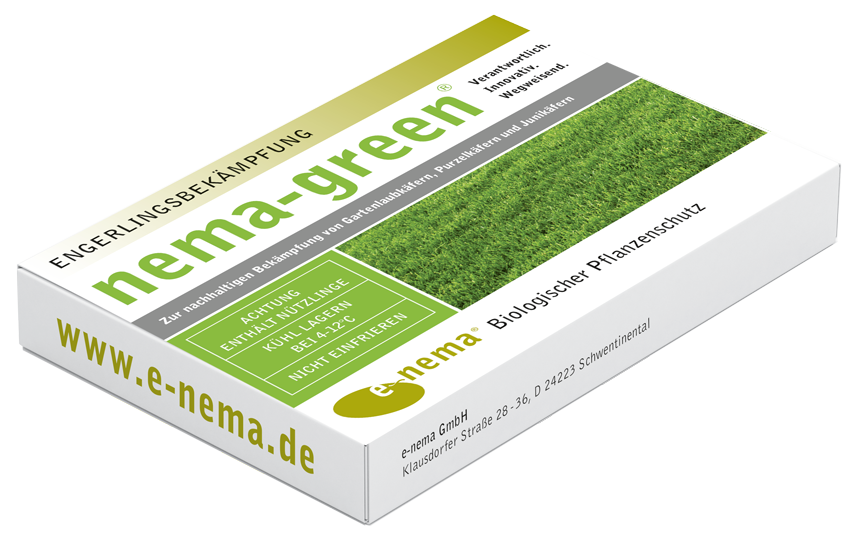Japanese
CONTROL JAPANESE BEETLE WITH NEMATODES
Popillia japonica
The Japanese beetle is an invasive polyphagous pest that is becoming increasingly widespread in agriculture, horticulture, and lawns. It was introduced to the United States from Japan in the early 20th century. It is now the main pest in green spaces and on athletic fields and golf courses in the eastern United States.
In Europe, it was first detected in Italy in 2014, since when it has continued to spread and cause significant damage. It is introduced as an egg or larva in the root balls of commercial plants.
In the EU and Switzerland it is considered a quarantine pest, i.e. it must be reported and controlled.
The Japanese beetle belongs to the leaf horn beetle family (lat. Scarabaeidae).
It is about 8-12 mm in size and similar in appearance to our native garden leaf beetle.
Important distinguishing feature: on each side of the body five, on the rearmost body segment two clearly visible, white hair tufts.
Its larvae are typical grubs.
Life cycle of the Japanese beetle
Eggs laid from May/June up to 10 cm deep in the soil.
After about 2 weeks, the larvae hatch and feed on plant roots.
In late fall, larvae retreat to deeper soil layers to overwinter.
In spring, larvae migrate back to upper soil layers and feed on roots again.
After 4-6 weeks pupation.
Beetles hatch in May/June, main flight period mid-May to mid-August.
Adult beetles live about 30-45 days.
Development from egg to adult beetle usually takes a year.
Damage caused by the Japanese beetle
Both the beetles and their larvae (grubs) can cause considerable damage when they occur en masse.
The beetle feeds on flowers, leaves (skeletal feeding), and fruits until they are bare.
The grubs feed on plant roots in the soil, and feeding can cause plant death.
Which plants are attacked by the Japanese beetle?
The diet of the Japanese beetle is diverse, including over 300 species of woody plants of various genera such as maple, beech and oak. As well as green areas, vegetables, ornamental plants, fruit trees, vines, agricultural crops such as corn, potato, asparagus, tomato.
Control of Japanese beetle with nematodes
Nematodes are tiny, filamentous soil organisms about 0.6mm long. They are natural enemies of the Japanese beetle. Our product nema-green® contains nematodes of the species Heterorhabditis bacteriophora. Among other things, this species is specialized on Japanese beetle larvae and can use them for its own nutrition and reproduction.
Which stages of the Japanese beetle are susceptible to nematodes?
The 2nd and 3rd larval stages of the Japanese beetle can be successfully controlled with the nematode Heterorhabditis bacteriophora.
The effectiveness of Heterorhabditis bacteriophora has been demonstrated by various scientists in various field trials:
In the Italian regions of Piedmont and Lombardy, our beneficial nematodes have been in use since 2017. There, they control the larvae of the Japanese beetle in meadows and pastures.
